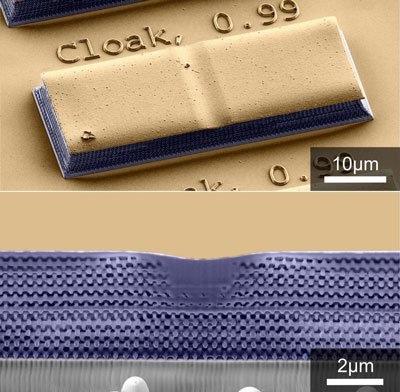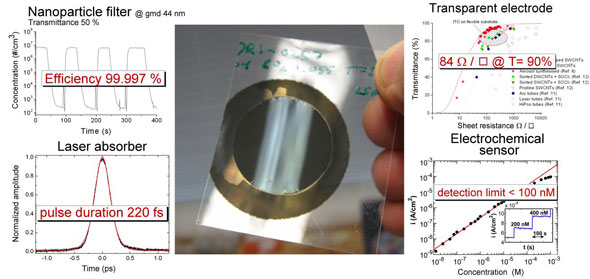EU-funded researchers from Germany and Poland have made some groundbreaking discoveries about cell cytoplasm viscosity, which could further our knowledge of the cytoplasm of cancer cells.
May 16th, 2011
Read more
Innovative collaboration between physics and cell biology demonstrates pathway.
May 16th, 2011
Read more
The Institute of Nanotechnology and NanoKTN are lending their significant support to NANO Live UK 2011.
May 16th, 2011
Read more
 Physiker haben am Center for Functional Nanostructures (CFN) am Karlsruher Institut fuer Technologie (KIT) in der Arbeitsgruppe von Professor Martin Wegener fast ein Jahr daran gearbeitet, die Struktur der Karlsruher Tarnkappe so zu verfeinern, dass sie auch in einem fuer den Menschen sichtbaren Bereich des Lichts wirkt.
Physiker haben am Center for Functional Nanostructures (CFN) am Karlsruher Institut fuer Technologie (KIT) in der Arbeitsgruppe von Professor Martin Wegener fast ein Jahr daran gearbeitet, die Struktur der Karlsruher Tarnkappe so zu verfeinern, dass sie auch in einem fuer den Menschen sichtbaren Bereich des Lichts wirkt.
May 16th, 2011
Read more
An international team, of scientists, led by a team at Monash University has found the key to the hydrogen economy could come from a very simple mineral, commonly seen as a black stain on rocks.
May 16th, 2011
Read more
The Nanoscale Effects in Tribology (NET 2011) Meeting will address the advances occurring in nanoscale tribology, providing attendees the opportunity to network, and discuss trends and future developments.
May 16th, 2011
Read more
 Scientists report a new method for revealing a 3D picture of the structure inside a material,
Scientists report a new method for revealing a 3D picture of the structure inside a material,
May 16th, 2011
Read more
 Today, Flanders' ambitious brain research that may lead to better diagnosis and treatment of brain disease, new prosthesis technologies for patients with a disability, a new generation of more intelligent robots, etc. switches into higher gear.
Today, Flanders' ambitious brain research that may lead to better diagnosis and treatment of brain disease, new prosthesis technologies for patients with a disability, a new generation of more intelligent robots, etc. switches into higher gear.
May 16th, 2011
Read more
Researchers at Hewlett Packard and the University of California, Santa Barbara, have analysed in unprecedented detail the physical and chemical properties of an electronic device that computer engineers hope will transform computing.
May 16th, 2011
Read more
Novel nano-mechanics: Mechanical resonators are extensively used in high-tech industry, to mark time in electronic components, and to stabilize radio transmissions.
May 15th, 2011
Read more
A special issue on Advanced Microelectronics Technologies is published in Volume 54, Issue 5 of SCIENCE CHINA: Information Sciences, in May, 2011. The issue contains 14 invited papers contributed by some leading researchers and internationally renowned experts in the field of microelectronics in both industry and academic from all over the world.
May 15th, 2011
Read more
 Dr. Shadi Shahedipour-Sandvik, Associate Professor of Nanoengineering at the College of Nanoscale Science and Engineering (CNSE), received the UAlbany Award for Excellence in Research on May 3, recognizing her for exceptional research over a sustained number of years.
Dr. Shadi Shahedipour-Sandvik, Associate Professor of Nanoengineering at the College of Nanoscale Science and Engineering (CNSE), received the UAlbany Award for Excellence in Research on May 3, recognizing her for exceptional research over a sustained number of years.
May 13th, 2011
Read more
Die Bundesanstalt fuer Arbeitsschutz und Arbeitsmedizin (BAuA) unter Mitwirkung des Verbandes der chemischen Industrie (VCI), des Bundesverbandes der Deutschen Industrie e. V. (BDI) und des Bundesministeriums fuer Bildung und Forschung (BMBF) startet eine zweite Fragebogenaktion zu Taetigkeiten mit Nanomaterialien in Deutschland. Ein pragmatischer Ansatz fuer eine offene Risikokommunikation steht dabei im Mittelpunkt.
May 13th, 2011
Read more
Research teams are trying different approaches within the nanotechnological field to improve water membrane technologies. One of these is to improve water purification by using nature's own water-transporting channels, aquaporins. However, constructing suitable membranes for industrial processes is a challenge.
May 13th, 2011
Read more
 Researchers have discovered a simple and rapid method to prepare thin multifunctional single-walled carbon nanotube films without any substrate (free-standing films).
Researchers have discovered a simple and rapid method to prepare thin multifunctional single-walled carbon nanotube films without any substrate (free-standing films).
May 13th, 2011
Read more
The presentations made during the "4th annual nanotechnology Safety for Success Dialogue Workshop" that took place on March 29-30, 2011, in Brussels, are now available for download.
May 13th, 2011
Read more






 Subscribe to our Nanotechnology News feed
Subscribe to our Nanotechnology News feed